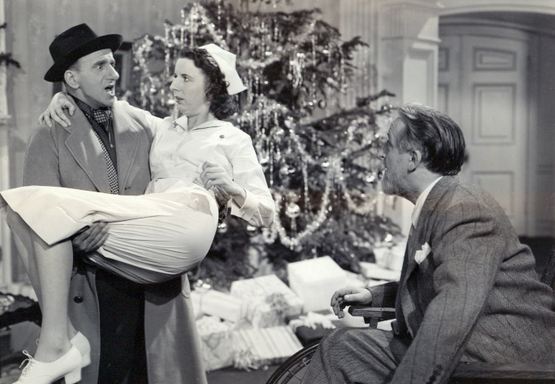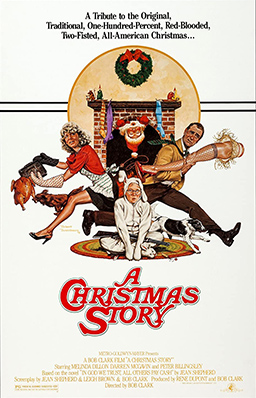(This first appeared 10 years ago, but I think it's always good to look at (my) classics again!)
I love a good Christmas movie or story, but I take my entertainment with a little salt, thanks. Or at least a shot glass. And a little murder just adds to the fun. Here's a list of my favorite Christmas movies, the ones my husband and I watch every year, and yes, we know the lines by heart:
I first saw this when I was ten years old, back in the 60's, watching it on a black and white TV set, all by myself. I laughed until I cried, and I remembered lines from it for years afterwards. It warped me for life.
"I read someplace that when a lady faints, you should loosen her clothing." - Albert (Aldo Ray)
"We came here to rob them and that's what we're gonna do – beat their heads in, gouge their eyes out, slash their throats. Soon as we wash the dishes." – Joseph
You can see where this is going: they get hired, they get interested, they get all warm fuzzy, they change their ways, everyone is happy. Right? Well, not quite. Because the big fat plum in this pudding is Basil Rathbone as Andre Trochard, who owns Ducotel's, and has come to Devil's Island - with his sycophantic nephew Paul - to do the books on Christmas Day. I love a good villain, and Basil Rathbone is as snooty, snotty, sneering, vindictive, scheming, insulting, arrogant, belittling, and generally nasty as they come. ("Your opinion of me has no cash value." – Andre Trochard.) He makes Ebenezer Scrooge look like a warm pussy cat.
Andre Trochard - "Twenty years in solitary – how's that for a Christmas present?"Jules – "That's a lovely Christmas present. But how are you going to wrap it up?"
There's no Ghosts of Christmas Past, Present, or Future in this one; no "God bless us, every one"; no Tiny Tim; but there's theft and forgery, fraud and deceit, murder and mayhem, all done with sharp, hilarious dialog. Go. Rent it now. Pour a Chateau Yquem (you'll understand later) or its equivalent, pull out a turkey leg, and enjoy! Merry Christmas! Compliments of the Season!
The Man Who Came to Dinner (1942), Monty Wooley, Bette Davis, Jimmy Durante, and more. The worst house guest in the world is also the most erudite, witty, arrogant, and popular man on the planet. Sheridan Whiteside was Kaufman and Hart's masterpiece (especially as played by Monty Wooley), based on (of course) the real Algonquin Club's founder, leader, gatekeeper and spoiled child, Alexander Woollcott.

Jimmy Durante, Mary Wickes (in her breakthrough screen role), and Monty Wooley
The play - and the movie - are chock full of characters who were based, almost libellously, on real people. Banjo = Harpo Marx. Beverly Carlton = Noel Coward. Lorraine Sheldon = Gertrude Lawrence, of whom Beverly Carlton says, in my favorite movie line of all time,
And Mary Wickes as Nurse Preen, who has to nurse the impossible Sheridan Whiteside:
"I am not only walking out on this case, Mr. Whiteside, I am leaving the nursing profession. I became a nurse because all my life, ever since I was a little girl, I was filled with the idea of serving a suffering humanity. After one month with you , Mr. Whiteside, I am going to work in a munitions factory. From now on , anything I can do to help exterminate the human race will fill me with the greatest of pleasure. If Florence Nightingale had ever nursed YOU, Mr. Whiteside, she would have married Jack the Ripper instead of founding the Red Cross!"
Somebody had to finally say it.
A/k/a Reborn (1981). Directed by Bigas Luna, "starring" Dennis Hopper as the snake-oil selling Reverend Tom Hartley, Michael Moriarty as Mark (a thickly-veiled Joseph), and (I kid you not, spoiler alert!) a helicopter as the Holy Spirit. While it has horrible production values, and was obviously made (in Italy, Spain, and Houston, TX) on rather less than a shoestring (I think all the money was spent on the helicopter), this may be one of the most interesting versions of the Nativity that's ever been done.
"You're going to have a baby? I can't have a baby! I can't even take care of myself, much less a baby!" Mark.
The Thin Man (1934). William Powell and Myrna Loy. Machine-gun dialog, much of it hilarious. A middle-aged peroxide blonde and an incredibly young Maureen O'Sullivan. More drinking than anyone would dare put into a movie today, at least not without a quick trip to rehab for somebody, especially Nick Charles. And mostly true to Dashiell Hammett's plot.
"Is he working on the case?" "Yes, a case of scotch!"
Okay, a quick break for myself and the kids and the grandkids: A Muppet Christmas Carol (with Michael Caine), A Charlie Brown Christmas, How the Grinch Stole Christmas (narrated by Boris Karloff) A Christmas Story. Love, love, love them ALL.
"You'll shoot your eye out!"
Okay, back to more adult fare:
Love Actually (2003), mostly because I start laughing as soon as Bill Nighy starts cursing. (What can I say? I'm that kind of girl.)
"Hiya kids. Here is an important message from your Uncle Bill. Don't buy drugs. Become a pop star, and they give you them for free!" Truer words are rarely spoken in a Christmas movie…
 |
| © IMDb |

|
 |
| © IMDb |
"Mrs. Scratchit, Tiny Tom is fifteen stone and built like a brick privy. If he eats any more heartily, he will turn into a pie shop." God bless us, everyone.
Scrooge (A Christmas Carol) (1951). Alistair Sim. This is my favorite version, mostly because it feels like Dickens to me, because I love Fezziwig's sideburns, because of the hysterical charwoman, but mostly because Mr. Sim's Scrooge really ENJOYS being a hard-hearted miser from hell. Which makes his delight, after coming back from his Christmas travels among the spirits, more believable. Or at least I always find myself grinning from ear to ear...
"I don't deserve to be this happy. But I simply can't help it!"
Merry Christmas, everyone!










.jpg)






